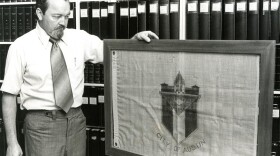Believe it or not, this month is Passport Awareness Month – the two-fortnight campaign in which the State Department encourages citizens to renew or apply for their passports. At worst, it’ll take six weeks to get a passport; at best, three weeks.
But, when Texas was a republic of its own, a passport was required by Texans to go really anywhere outside of the massive swath of land that made up the fledgling republic. The official documents were also required to cross the borders into Texas.

Turns out, it wasn’t that hard to get a passport in those days. One could write a letter, which was reviewed by the State Department, who'd send along passports if travel requests were approved. That passport, it should be noted, was essentially a letter as well.
For example, Sam Houston’s “application” for a passport listed likely potential destinations, like the United States and even Canada. But, to cover his bases, Houston also listed faraway locations France, Great Britain and Ireland, though he never visited any of those places during Texas’ stint as a republic.
Texas’ state department didn’t really have stationery, so officials sometimes simply drew the state seals themselves. These handwritten letters with hand-drawn seals were basically akin to permission slips from a parent to go on a field trip. That changed slightly after the self-proclaimed republic gained its independence. A passport granted to a William Miller for a trip to the U.S. features signatures, witnesses and was one of several to be authorized by Stephen F. Austin during his two-month stint as Secretary of State before his death.

Over the years, the passports adopted more or less modern standards of identification and continued into the 1850s, despite the fact that Texas was by then a state.
The passports didn’t, however, have the luxury of images. To make up for the lack of photo identification, one 1858 passport for Travis County Judge John B. Costa outlined his physical description, calling his forehead “prominent” and his face “tolerable” and “full.”

Passports were also used as a diplomatic tactic in Houston’s negotiations with Native American tribes. Houston personally wrote a passport for three chiefs of the Comanche tribe in 1838, shortly before his second term as President ended.
They were also used to bring folks in, as well as flee, Texas in the gap years between independence and annexation by the United States. What was perhaps the largest passport was granted in 1836 to Dr. John Sutherland and Dr. J.G. Williams. The passport includes 287 additional people – some of whom would become members of the Galveston City Company, which organized the city’s infrastructure and sold real estate after the war.
You can view the state's full archive of 55 Texas passports on the Texas State Library and Archives' website.
If you get fed up waiting for your U.S. passport renewal, you can pay $36 online for a novelty passport. If you want to make it official, you can fill out a form to receive a passport from a secessionist group known as the Republic of Texas and receive a passport that, in the event of the state's dissolution of ties with the union, will allow you to return to Texas.






